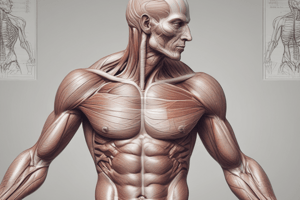Podcast
Questions and Answers
What is the main focus of microscopic anatomy?
What is the main focus of microscopic anatomy?
- Observation of larger body structures
- Study of bones and muscles
- Examination of visible bodily features
- Study of cells and histology (correct)
Which branch of anatomy looks at the interrelationships between all structures in a specific region like the abdomen?
Which branch of anatomy looks at the interrelationships between all structures in a specific region like the abdomen?
- Microscopic anatomy
- Regional anatomy (correct)
- Gross anatomy
- Systemic anatomy
What does gross anatomy primarily focus on studying?
What does gross anatomy primarily focus on studying?
- Large molecules within the body
- Visible bodily features (correct)
- Cells and histology
- Structures observable under a microscope
Why is studying anatomy important?
Why is studying anatomy important?
Which approach to studying anatomy focuses on the complex interplay between muscles, nerves, blood vessels, and other structures in serving a specific body region?
Which approach to studying anatomy focuses on the complex interplay between muscles, nerves, blood vessels, and other structures in serving a specific body region?
What distinguishes microscopic anatomy from gross anatomy?
What distinguishes microscopic anatomy from gross anatomy?
Flashcards are hidden until you start studying
Study Notes
Human Anatomy
Human anatomy is the scientific study of the body's structures. It involves examining various aspects of the human body, ranging from the smallest cells to the largest organs, using a variety of techniques and technologies. By studying anatomy, we gain a better understanding of how our bodies function and how they maintain homeostasis, the state of steady internal conditions maintained by living things.
Gross Anatomy vs. Microscopic Anatomy
Gross anatomy, also known as macroscopic anatomy, is the study of the larger structures of the body that can be observed without the need for magnification. This includes the study of bones, muscles, and other visible bodily features. On the other hand, microscopic anatomy focuses on structures that can only be observed under a microscope or other magnification devices. This includes the study of cells, histology (the study of tissues), and even the study of large molecules within the body.
Approaches to Studying Anatomy
Anatomists take two general approaches to studying our bodies' structures: regional anatomy and systemic anatomy. Regional anatomy examines the interrelationships between all the structures in a specific region, such as the abdomen. This helps us appreciate the complex interplay between muscles, nerves, blood vessels, and other structures in serving a particular body region. In contrast, systemic anatomy focuses on the structures that make up a discrete body system—a group of structures working together to perform a unique body function. For example, studying the muscular system would consider all of the skeletal muscles in the human body.
It's important to note that while form (anatomy) is closely related to function (physiology), they are distinct disciplines. Human physiology is the scientific study of the chemistry and physics of the structures of the body and the ways in which they function. Physiologists may specialize in neurophysiology, exploring the brain, spinal cord, and nerves, or work at the molecular level, studying how electrochemical signals travel along neurons.
Studying That Suits You
Use AI to generate personalized quizzes and flashcards to suit your learning preferences.




